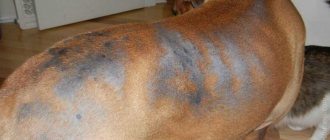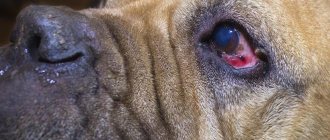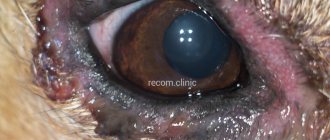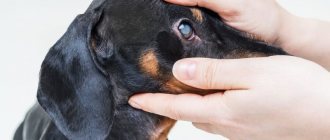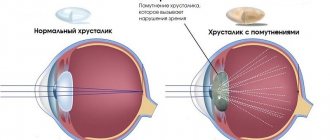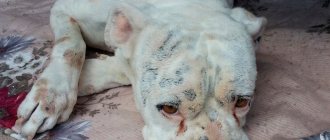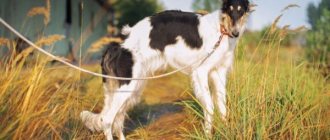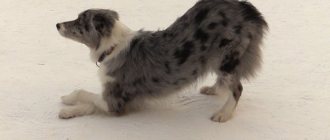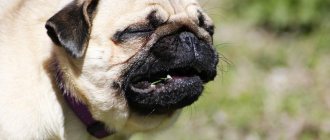“Beauty” and “health” are almost synonymous. These two indicators are closely related. Typically, health problems are reflected in appearance - it changes for the worse, which affects overall well-being, mood, and interest in life.
To prevent or avoid, you need to know the factors and conditions that influence deterioration of health.
Causes of the disease
There are many reasons why hair may fall out around the eyes. Some of them are associated with allergic reactions. They can be triggered by the food you eat. In most cases, the cause lies in a food allergen or an excess of proteins in the foods the dog is fed. More often this happens when feeding the animal natural, homemade food.
Loving owners without a second thought put plenty of chicken, fresh cottage cheese, eggs, and liver into their pet’s bowl, not realizing that they can provoke unwanted health problems.
The same thing happens when you wash your dog too often and use too aggressive or “human” cosmetics that are not suitable for the dog. This can be soaps with fragrances, shower gels, shampoos and even perfumes and deodorants.
Animals with hypersensitive skin and coat may react to them. Since the skin around the eyes is the thinnest and most delicate, it is the first to become a “victim of allergies.”
In young dogs, juvenile blepharitis can cause hair loss. With it, the eyes begin to water, ache and become inflamed, suppuration appears, and then hair is lost. Another disease can provoke the same manifestations - meibomitis, or inflammation of the meibomian gland. It is located in the thickness of the eyelid and manifests itself as an internal “stye”.
Old age, metabolic disorders, hormonal problems, the presence of helminths and skin parasites, such as mites, can also provoke baldness.
Why does a dog lose hair in places (on the back and around the eyes): reasons, vitamins, what to do?
The process of hair loss in animals is called alopecia.
Canine hair loss
Hair loss is more noticeable in long-haired dog breeds!
Baldness is not always a pathology.
Hair falls out on the back
Hair falls out around the eyes
Pathological factors of hair loss
Factors causing baldness are divided into hormonal and non-hormonal factors. Hormonal factors include:
- excess cortisol;
- growth hormone imbalance;
- excess estrogen;
- estrogen deficiency;
- hypothyroidism
Baldness can occur due to hormonal imbalance.
Hyperadrenocorticism
Due to changes in the functioning of the adrenal glands, excess cortisol hormone is formed in the blood.
Estrogen is a hormone produced primarily in females.
The hormone estrogen is mostly present in females.
The hormone is also present in the body of males, however, in small quantities. The cause of hyperestrogenism can be: artificial hormone intake, ovarian cysts, ovarian tumors, neoplasms in the testes.
Hypoestrogenism
Hypoestrogenism develops due to too early sterilization of the female.
Early sterilization of a dog leads to hypoestrogenism.
The absence of ovaries significantly reduces estrogen production, and in some cases, its formation stops altogether, which leads to hair loss.
Hypothyroidism
Hypothyroidism in dogs develops due to a congenital or acquired cause, which is associated with a violation of the production of thyroid hormone. These could be thyroid tumors, iodine deficiency, or infectious diseases.
Hypothyroidism can be caused by heredity.
Other reasons
The dog has ringworm.
And non-hormonal factors may also be the cause. These factors include:
B vitamins affect the metabolism in the animal's body and the level of hemoglobin in the blood . The lack of this vitamin is caused by diseases of the digestive system, pregnancy, lactation, and excessive stress.
Allergic reactions can occur to food, medications, and plants. But the presence of an allergen can also be in hygiene products. The pet reacts to household chemicals, house dust, exhaust fumes, and flea saliva.
Associated symptoms and causes
Cushing's syndrome is characterized by increased thirst.
Hypothyroidism does not have clear symptoms. The main symptoms are expressed by the following manifestations:
Complicated symptoms include constipation and laryngeal paralysis. Constant belching, hiccups.
Group B vitamin deficiency is characterized by symptoms of a disorder of the central nervous system. Sudden weight loss, unsteady gait, convulsions. At times, loss of orientation occurs in more severe cases. Aggression, fear, and unreasonable running often begin.
Associated symptoms of an allergic reaction include swelling of the muzzle and lacrimation. Nasal and ear discharge, skin itching, redness, unpleasant odor from the skin and fur. A rash of various shapes is possible.
Yeast dermatitis
Yeast dermatitis causes itchy skin.
Symptoms vary depending on the type of scabies. Pruritic scabies is characterized by severe, incessant itching, the formation of hard crusts on the skin, sudden weight loss, fever, and enlarged lymph nodes. Demodectic mange has no associated symptoms other than baldness.
The dog has demodicosis.
Ringworm is characterized by severe anxiety, a red rash, and significant itching. The fur falls out in clumps, extensive bald patches appear, the skin flakes and becomes crusty. As a result of scratching, pustules, wounds, and ulcers appear.
Dog treatment
The drug Levothyroxine treats hypothyroidism.
Prevention
A prerequisite for preventive measures is cleanliness. It is unacceptable to keep a pet in dirty and unsanitary conditions. It is necessary to systematically bathe the puppy using special shampoos that prevent the appearance of insects.
To prevent the disease, you should use a special shampoo.
Video about dog grooming
Add a comment Cancel reply
- Why are the cat’s pupils dilated over the entire eye and do not react to light - 16.10.
- The cat’s nose can’t breathe and his eyes are watering, what should I do? — 16.10.
- Why does a cat vomit after eating any food (rapidly losing weight) - 16.10.
Cats and dogs rule
Portal about cats - all photographs with the author's mark (watermark) are protected by NOTARY! When copying materials from the site, be sure to provide a link to the source! © —
https://mykoshka.ru/pochemu-u-sobaki-vypadaet-sherst-mestami/
Types of baldness in dogs
Demodectic mange can cause baldness. There is itching. Blisters may form. There is an unpleasant smell. The skin around the eyes turns red. Baldness is more common in the spring.
Hair loss can be focal - when the hair falls out in patches, or generalized - when the hair “climbs” all over the body. Alopecia around the eyes, the so-called spectacle alopecia, occurs as a result of a pathological process that develops as a result of various diseases. Main diseases:
- demodicosis;
- juvenile blepharitis;
- meibomite;
- allergy.
However, baldness is not always associated with diseases. Often a dog simply sheds, and if such a sign is detected at an early age, then most likely this is a natural feature of a particular puppy.
Causes and symptoms
Demodicosis is caused by the parasitic Demodex mite, whose main food is skin and loose fiber.
Demodex mite under a microscope.
It is characterized by seasonality, occurring mainly in spring, summer, and early autumn. “Middle-aged” pets rarely get sick; young animals under one year of age and individuals more than ten years old are more likely to become infected. The type of infection is contagious, from other sick animals.
With demodicosis, severe itching is noted. The dog begins to itch even if nothing is visible on the skin yet. Next, redness of the skin is noted at the very roots, and after some time, blisters with brown exudate inside form at the site of hyperemia. This pathology affects not only the eyes, but can also spread throughout the body. At the site of the lesion, hair begins to fall out in clumps, and the blisters open spontaneously. The pustules give off a strong, foul odor. Often a dog's body temperature may rise.
Juvenile blepharitis (eyes)
Juvenile blepharitis is an inflammatory process of the eyelids.
If blepharitis is not treated, the dog may go blind.
It is characterized by both unilateral and bilateral infection. May be complicated by inflammation of the inner eyelid and conjunctiva. Main symptoms:
- redness of the eyelid;
- swelling of the eyelid;
- itching;
- mucous or purulent discharge;
- the appearance of crusts;
- formation of pustules;
- alopecia.
Blepharitis is a pathology that should never be ignored. If treatment is not started in a timely manner, it can result in blindness for the pet.
Meibomite
Meibomite is often confused with ordinary barley, but the nature of this pathology is somewhat different.
Meibomite is similar in symptoms to regular barley.
Meibomitis develops due to inflammation of the meibomian glands, which are located in the cartilaginous plates of the eyelids. According to the type of course, acute and chronic courses are distinguished.
It is expressed by symptoms similar to barley, however, the damage with meibomitis is deeper and the inflammatory process is localized in the cartilage itself, which is often expressed by eversion of the diseased area. The eyelids are swollen, inflamed, and there is discharge from the eyes. The dog tries to scratch, but cannot, since any touch responds with pain.
Allergic reactions
In case of an allergic reaction, nasal discharge is observed.
Baldness is often associated with allergic reactions. Hair loss around the eyes is most often associated with drug allergies. With this pathology, there is itching, redness, possible lacrimation, and nasal discharge. An increase in body temperature occurs less frequently.
Photo of a dog going bald around the eye
As you can see, hair loss around the eyes in dogs does not pose serious dangers, but it is still worth paying attention to this symptom in order not to trigger possible demodicosis or lichen.
Baldness treatment
Therapeutic measures for demodicosis involve treatment in a clinic under the supervision of a doctor.
- The first step is eliminating the parasite.
- Local treatment of the purulent lesion is carried out, drugs are prescribed that restore the immune system, and intoxication of the body is removed.
- Recommended medications: ivermectin, doramectin, yam ointment, aversectin ointment.
The drug Ivermectin restores the dog's immune system.
Blepharitis is eliminated by removing eye discharge using a sterile solution and warm compresses. Antibacterial therapy in the form of drops or ointments and antiparasitic agents are used. Sometimes surgery may be necessary. Developed ocular abnormalities or seals are promptly eliminated. Immunosuppressants may be used.
The dog has blepharitis.
Treatment of meibomitis should begin with help to accelerate the maturation of the abscess. To do this, the animal should apply hot compresses until maturation occurs. Next, an autopsy is performed. Disinfect the opening site and the needle that will be used for manipulation and carefully open it. You can apply light pressure to allow the purulent exudate to flow out. Immediately after the operation, it is necessary to lubricate the wound with antiseptic ointment. It is recommended to use erythromycin ointment.
After surgery, Erythromycin ointment should be used.
Drug allergy
Drug allergies are eliminated by stopping taking medications.
If it is vital for an animal to take medication at the moment, you should look for acceptable analogues. You can use antihistamines - suprastin, execan in the form of sugar cubes. If there is even the slightest possibility of stopping the medication at this time, you should do so immediately.
Suprastin is an antihistamine.
Demodicosis as a cause of alopecia
Endoparasitism has made mites of the genus Demodex of the family Demodicidae so small that they cannot be seen with the naked eye. Demodex live in the sebaceous glands and hair follicles of mammals. Young adult ticks go through a phase of cutaneous existence. Then they spread the population throughout all the productive sebaceous glands of the “host”.
Development of demodicosis in dogs
The genus Demodex is divided into species depending on its preferred host. There are 3 types of dogs to choose from. The most common follicular mite, Demodex canis, is aggressive. Causes red iron (iron scabies, demodicosis) - a severe, very itchy, torpid (little sensitive) to therapy and sometimes fatal disease.
The red iron worm does not spread to people, even with close, repeated contact with a sick animal. Humans have their own endoparasite mite of the Demodex genus - Demjdex folliculorum.
Demodex itself is not a particularly harmful parasite; its presence on the skin is not a disease. Cohabitation with Demodex canis is harmless to the dog. But if the irritation from the waste products of the tick is layered on the skin manifestations of any disease, it will greatly complicate it.
Demodectic mange in a dog
It’s another matter if the number of parasite individuals increases rapidly. Then the damage to the entire animal’s body begins. Generalized demodicosis is considered:
- if there are more than 5 focal lesions;
- or affected, at least 2 limbs (this is podomodecosis);
- Dermatitis covers an entire region of the dog's body.
The host body is not able to regulate the number of mites. Therefore, treatment is necessary.
The other two species of endoparasitic ticks of the genus Demodex that live on dogs are:
- Demodex cornei (short-body mite);
- species without a nomenclature name (with an elongated body).
Demodicosis affects even small puppies
The juvenile form of demodicosis affects puppies (under 18 months of age). The second risk group is dogs over 4 years old. The disease progresses in a scaly or pustular manner.
The scaly form of generalized demodicosis (squamous) is expressed by erythema - dilation of the capillaries and, as a result, severe redness of the skin, swelling, and the release of sticky liquid - exudate. With this course of the disease, spotted alopecia, dandruff, and comedones (acne) are found on the dog’s skin. The pustular form of demodicosis resembles folliculitis and furunculosis. The reason is the addition of bacterial microflora. The combination of two forms - squamous and pustular - is rarely observed.
Generalized demodicosis in dogs
Causes of demodicosis
Possible factors predisposing to the development of generalized demodicosis:
- heredity;
- suppression of immunity (immunosuppression);
- endocrinological pathologies.
Diseases that create conditions for excessive reproduction of demodex can usually be identified after a year and a half. Therefore, demodicosis is treated first.
Treatment of bacterial infection
Having identified the parasite, they begin therapy:
- reduce the colony of ticks;
- then suppress bacterial infections;
- treat demodicosis;
- begin to discover the reason for its generalization - its widespread distribution.
Scraping allows you to see the parasites that cause alopecia
To make a diagnosis, the epithelium is collected - with a deep scraping - from the site of scratching or inflammation. Areas with comedones and border areas of affected and healthy skin are preferable for analysis. If the lesions are localized on the dog’s paws, in the folds of the skin (for example, in a Shar Pei), a biopsy is needed - excision of a piece of epithelium. The collected material is viewed through a microscope.
Elimination of suppuration (pyodermitis) is a prerequisite for successful treatment of demodicosis. Bacterial infections cause immunosuppression of the skin, which creates conditions favorable for the reproduction of the endoparasite.
The doctor initially prescribes antimicrobial drugs for a period of 4 to 7 weeks. Whether it is worth extending the appointment is determined by a cytological examination. There are enough clinical symptoms to understand that the medicine needs more time to destroy microorganisms.
It is better to wash the affected animal with gloves.
Weekly, in parallel with the main treatment of pyodermatitis, the dog is washed with antibacterial shampoos:
- chlorhexidine;
- benzyl peroxide.
Attention! If the doctor has given preference to benzyl peroxide shampoo, relying on its ability to penetrate the hair follicles, you need to be very careful when using it. It is important not to look at possible side effects: excessive dryness, skin irritation, and discontinue shampoo.
After bathing, it is permissible, as prescribed by a doctor, to apply conditioner (for example, “Alpha Keri bath oil”) to the dog’s body and rinse off.
Antibacterial shampoos not only treat the skin, but also relieve itching
Treatment of demodicosis
Having rid the dog of pyodermatitis, they take demodicosis seriously. Additionally, the epidermis, blood, and urine are examined to identify diseases that suppress the immune system. The doctor uses local and oral medications to fight demodicosis.
Amitraz is applied to the body in a concentration of 300–600 (mg/l of water) once every few days, usually from 3 to 7. With a more concentrated solution, if the doctor deems it necessary, treat half of the body each time, alternating left and right. Before applying amitraz, the hair is cut, the skin is cleaned of crusts and exudate with a non-irritating shampoo, and the dog is carefully wiped until dry.
Before applying a local drug for demodicosis, wash the dog with a mild shampoo
Amitraz is toxic! The smaller the animal’s body weight, the more likely and stronger the undesirable effects of its use are:
- oppression;
- decreased heart rate (bradycardia);
- decrease in body temperature;
- flatulence;
- increase in daily urine volume;
- increased glucose levels;
- vomit.
Dogs weighing up to 5 kg most often do not tolerate amitraz well.
Attention! In a person with hypersensitivity, amitraz causes contact inflammation, migraine, and asthma. Prepare a solution and treat the dog with it in a spacious, open room, wearing gloves and a respirator.
The use of oral medications is more convenient and does not require grooming the dog, but their side effects are more pronounced. The effectiveness of ivermectin, milbemycin, and maxidectin has been proven.
Ivermectin is toxic! It is taken according to a special regimen, under the supervision of a doctor, and is immediately canceled if any symptom occurs. Treatment with ivermectin lasts 10–20 weeks, the daily dosage is no more than 300 mcg per 1 kg of dog’s body weight.
Manifestations of neurotoxicity of ivermectin:
- salivation (salivation);
- bradycardia;
- uncoordinated movements, loss of balance (ataxia);
- dilated pupils;
- involuntary rhythmic muscle contraction (tremor);
- inactivity, indifference to stimuli (stupor);
- stopping breathing.
Not all dog breeds tolerate ivermectin
Collie and bobtail dogs are especially susceptible to intolerance to ivermectin. To determine the sensitivity of the dog’s body to the medicine, administration begins with small doses - 50 mcg. Increase the dose gradually, adding no more than 50 m/kg: 100, 150, 200, 250, 300.
Attention! Ivermectin should be discontinued immediately if there is any sign of neurotoxicity in the dog! Its symptoms must be known and understandable to the owner. Ivermectin is contraindicated for puppies under 12 weeks of age!
Milbemycin is less toxic. It is prescribed after canceling ivermectin, or initially, if its higher price is “lifting” for the owner, and always for small dogs. The duration of use of milbemycin is 2–6 months at a dosage of ½–1 mcg (less commonly, 2 mcg) per 1 kg of dog body weight per day.
Possible side effects of maxidectin are similar to those of ivermectin, swelling of the muzzle is possible, but they are less likely to occur. Dosage – 200–400 mcg/kg/day.
Demodex colony monitoring is mandatory throughout the treatment period. Scrapings to determine the number of mites and stages of the life cycle of individuals are performed monthly and, based on the results, treatment is continued until the next scraping or 1 month until completion.
Local manifestation of demodicosis
If the number of individuals does not decrease, change the treatment tactics. The goal of treatment is to destroy all Demodex individuals. They will still settle on the dog sooner or later and spread throughout all seborrheic areas of the skin. But absolute destruction is the key to a long relapse-free period.
Prevention
Regarding preventive measures, several important points can be highlighted.
It is necessary to regularly clean the area where the dog lives.
- The animal must be kept clean.
- Regularly sanitize the dog’s premises, sleeping area or kennel.
- Monitor the condition of the coat.
- Avoid places where there may be insects, prevent questionable contacts with other animals.
- Timely vaccination and deworming.
- Eliminate access to paint products or household chemicals.
- Under no circumstances should you self-medicate.
- All prescriptions must be prescribed by a doctor.
The first “bells” that a dog’s eye is beginning to become inflamed are quite difficult to recognize, especially if you are a novice dog breeder. Slight tearfulness, slight swelling of the eyelids, itching in the eye area are obvious but subtle signals. According to the rules of keeping pets and for the benefit of your pet, the dog must be examined daily, you are interested in the condition of the coat, mouth, teeth, ears and, of course, the eyes. Let's consider the main causes of inflammation and symptoms indicating the disease.
Conjunctivitis
The first and most logical suspicion for reddened eyelids is the onset of conjunctivitis. The disease is quite harmless if treated. The dog's eyes will itch, and you will notice that the pet is rubbing its muzzle with its paws. The eyelids stick together after sleep, and around the eyes there is a clear, yellow or yellow-green discharge, the mucous membrane is swollen and red. At the initial stage, treatment is carried out at home:
- We rinse the eyes with warm, clean water or herbal infusions if we are sure that the dog does not have allergies. A clean piece of gauze or sponge is used for each eye.
- Levomycetin drops are instilled into each eye (3–6 times a day) or Tetracycline ointment is applied (2–3 times a day).
- Treatment lasts 7–10 days. After complete disappearance of symptoms, therapy is continued for 2–3 days.
Purulent inflammation of the eyes in dogs, which spreads to the nasal passages and ears, is the next, advanced form of the disease, which requires consultation with a veterinarian and “aggressive” treatment with antibiotics. There is also a little-known form of the disease - follicular conjunctivitis. Inflammation of the mucous membrane of the eye looks like overripe raspberries, and other symptoms are similar. The difference is that the follicular form is most often chronic, worsens from time to time and can only be stopped in a clinical setting by cauterization.
Important! Inflammation of the eyelids is a consequence of a silent illness or neoplasm, most often observed in older dogs. The disease looks like the initial stage of conjunctivitis, but does not go away with treatment.
Viral infection
Perhaps the most dangerous case, where eye inflammation is only the first and most harmless alarm signal. Just because your dog is vaccinated does not mean he is completely safe. We develop weak immunity to some viruses. Common viral infections that cause eye inflammation include:
- Canine viral hepatitis or Adenovirus - affects the internal walls of the vessels lining the entire circulatory system of the animal. The pancreas and thyroid gland, lungs, spleen, kidneys, but primarily the liver and eyes are affected. The dog survives only with a simple and late form of hepatitis, however, complications cannot be avoided.
- Canine distemper is an acute infectious disease that affects young dogs aged 3 to 12 months. Depending on the location, there are pneumonic, intestinal, cutaneous, nervous and acute forms of canine distemper. With timely diagnosis and treatment, there is a chance of survival. The disease is considered fatal, so vaccination is recommended for all dogs.
- Mycoplasmosis is a viral infection that massively affects the entire dog’s body. Even if recovered, the pet may become infertile, suffer from arthritis, or have recurring genitourinary infections. In its acute form, the disease is complicated by pneumonia, colitis and infectious diseases of the genitourinary system.
There are many dog diseases that owners may not be aware of until the disease develops and manifests itself as serious symptoms. Such diseases include most pathologies affecting the animal’s organs of vision. What eye diseases in dogs should you pay attention to in order to find out as early as possible that the dog is not healthy? After all, early diagnosis allows you to treat your pet in a timely manner before complications arise.
Symptoms of alopecia in dogs
Each type of alopecia has its own characteristics, and there is no single clinical symptomatology. Depending on the cause and type of hair loss, dogs suffer from the following symptoms:
- Baldness due to hormonal imbalance is characterized by uniform or focal hair loss, as well as hyperpigmentation (Alopecia X).
- Seasonal shedding is characterized by uniform thinning and hair loss, but not completely.
- An unbalanced diet leads to alopecia in the form of severe thinning of the coat.
- After grooming, the symptom will be that the coat does not recover for a month.
- Allergies are characterized by alopecia areata, sores and redness in areas of baldness.
- Parasitic baldness manifests itself focally, the dog makes bald patches by scratching.
- Stress baldness is characterized by uniform loss and thinning of a dog's hair.
- During pregnancy, hair falls out evenly and the hair becomes thin. After childbirth, the fur is gradually restored.
Differential diagnosis based on the symptoms of alopecia is impossible; to determine the causes and type of disease, you need to contact a veterinary clinic where research will be carried out.
Blepharospasm: symptoms and treatment
If your pet begins to blink quickly and without stopping, then this is a sure sign of blepharospasm - an accelerated and unconscious contraction of the muscle tissue of the eyelids. In addition, the following symptoms are present:
- the eye and the inflamed area around it may swell;
- palpation causes pain;
- the pet exhibits photophobia, that is, it avoids looking at the light;
- Inflammatory fluid is released from the eyes - exudate.
In itself, this pathological condition is not dangerous, but its manifestation should alert the owner, since blepharospasm is not an independent disease, but only a symptom of inflammatory or infectious eye processes developing in the body, for example, inflammation of the trigeminal nerve.
There is no separate treatment for blepharospasm, since it disappears only after the root cause is eliminated, that is, the disease that caused this condition is cured.
For pain relief, special drugs used in ophthalmology are used, for example, Ledocaine. Without certain skills, such tools cannot be used! Most of them, due to the high content of toxins, are used only in this area and, if dosed incorrectly, can poison the pet.
Third eyelid prolapse: symptoms and treatment
This disease has another name - “cherry eye”, it is due to the fact that the eyeball really becomes like an overripe cherry berry. With this pathology, the dog's third eyelid leaves its usual place and ends up in the corner of the eye. In most cases, only one eye is affected, but bilateral prolapse also occurs.
Modern medicine has not yet fully figured out the reasons for this condition, but most often the third eyelid moves out of place due to the weakness of the tissues that hold it. There are breeds of dogs in which this condition is congenital and all representatives have a tendency to exhibit “cherry eye.” These include: bulldogs, English cocker spaniels, hounds.
Research has shown that the disease can be hereditary. If the dog’s parents, or at least one of them, have a predisposition to this pathology, then it will certainly manifest itself in subsequent generations. If, when purchasing a pet, such a diagnosis is written down in the card, then it is better to refuse the purchase.
The disease does not threaten the life of the animal, but there are several negative aspects:
- the pet's appearance deteriorates;
- dogs with this disease are not the best option for breeding;
- prolapse affects the activity of the lacrimal glands, which provokes frequent inflammatory processes of the conjunctiva (conjunctivitis) and the cornea of the eye (keratitis).
Definitely, this disease requires timely treatment and most often it consists of surgery. This is due to the fact that once the eyelid falls out, it will constantly leave its place.
The operation itself is not complicated, but it leads to dysfunction of the lacrimal gland. The pet owner will need to carry out maintenance therapy throughout his life - use eye drops or saline solution to moisturize the mucous membranes of the eyeball.
Clinical manifestations and therapy of eyelid dermatitis in dogs
This disease cannot be called an eye disease, but the pathology often develops into an eye disease. Among the main features are the following:
- an inflammatory process develops on the skin of the eyelid, they turn red;
- wet areas appear;
- pus may appear;
- the dog has an unpleasant, nauseating odor;
- eyes turn sour;
- Exudate (inflammatory fluid) is released from the eyes.
In such conditions, it is quite logical that over time, pathogenic microorganisms spread to the conjunctiva. Most often, this disease is diagnosed in pets with long hair and floppy ears.
Antibiotic drugs with a wide spectrum of action are used as treatment. The hair from the affected areas must be cut off, and a special ointment with an antiseptic effect is applied to the skin. Antimicrobial drugs should be instilled into the eyes; before doing this, it is advisable to rinse them with saline solution, which must be sterile.
In order to prevent your pet from scratching the sore eyelids, a medical collar is used.
Conjunctivitis in dogs
Symptoms and treatment of conjunctivitis
Inflammation of the conjunctiva of the eyes is the most common eye disease in both humans and animals, which in most cases is infectious in nature. In addition, the causes of the disease may be:
- viruses;
- allergic reaction;
- inflammatory process in the tear ducts or their blockage (in this case, the conjunctiva remains without the necessary moisture);
- getting a foreign object into the eye;
- irritant substances that have penetrated the area of the conjunctival cavity;
- irritation resulting from inversion of the eyelid (eyelashes damage eye tissue);
- mycoses.
The clinical picture looks like this:
- the mucous membranes of the eyes become pink or red;
- the tissues of the eyes and eyelids may swell;
- discharge appears from the eyes - this can be clear tear fluid, watery exudate or purulent clots;
- Part of the third eyelid may appear in the inner corner of the eye - dog owners who have no experience may think that this is a bulging eye.
Your pet may have squint or constant blinking. The last sign can be painful; in this case, the dog will be restless, often rub its eyes and whine pitifully.
Often conjunctivitis is accompanied by the same symptom as with keratitis - clouding of the cornea of the eye.
If we talk about the treatment of the disease, it depends on the cause of inflammation of the conjunctiva. Most often, therapy involves the use of antibacterial drugs - drops, ointments and other forms of medicines. Among external medications, the most popular is tetracycline ointment.
But before prescribing treatment, the veterinarian must conduct a thorough diagnosis, study tests, and only after receiving the results decide on therapy.
Ectropion in dogs
Diagnostics
First of all, the veterinarian will perform an external examination of the dog and take an anamnesis. Next, the doctor will choose one of the diagnostic methods to detect alopecia in a pet:
- Biopsy;
- Phototrichogram;
- Glow with an ultraviolet lamp;
- Biochemical, mycological and bacteriological studies of skin scrapings;
- General analysis of blood, urine and feces.
Read Causes of adenovirus infection in dogs: signs and methods of treatment
An ultrasound may be prescribed to examine the functioning of the thyroid gland. The activity of B- and T-lymphocytes in the blood, the content of antigens and protein are being studied.
Ectropion and entropion: symptoms and treatment
In simple terms, we are talking about eversion and inversion of the eyelids in dogs. These pathologies can be called truly canine ailments, since they are diagnosed extremely rarely in other animals.
The diseases are hereditary, and representatives of the following breeds are especially susceptible to them - Staffordshire Terriers, Basset Hounds, Shar-Peis, Great Danes, Ridgebacks, Dachshunds, Chow Chows, Newfoundlands, some types of Spaniels, St. Bernards.
When considering these ailments (volvulus and eversion), they can be combined, since they often develop in parallel. Of course, inversion of the eyelids leads to more serious consequences, but their inversion leaves the eyeball without any protection from pathogenic pathogens.
In addition to pathological changes in the appearance of the eyes, these diseases are accompanied by the release of fluid, constant blinking, and the animal feels pain when pressing.
With ectropion, the conjunctiva is deprived of moisture and dries out, which can cause the development of keratitis and other serious disorders.
Sometimes inversion of the eyelids leads to ingrowth of eyelashes into the eye tissue and this ailment is already considered an independent disease.
Treatment of eversion and entropion of the eyelids is most often carried out surgically, and it can only be carried out in adults whose growth has stopped. Conservative therapy takes place, but only if the pathology is in the initial stages of development.
To eliminate the symptoms and causes of the disease, antibacterial agents, antiseptics, hormone therapy and other medications are used.
Blepharitis in dogs
“Beauty” and “health” are almost synonymous. These two indicators are closely related. Typically, health problems are reflected in appearance - it changes for the worse, which affects overall well-being, mood, and interest in life.
To prevent or avoid, you need to know the factors and conditions that influence deterioration of health.
Why does a dog lose hair in places (on the back and around the eyes): reasons, vitamins, what to do?
The process of hair loss in animals is called alopecia.
Canine hair loss
Hair loss is more noticeable in long-haired dog breeds!
Baldness is not always a pathology.
Hair falls out on the back
Hair falls out around the eyes
Pathological factors of hair loss
Factors causing baldness are divided into hormonal and non-hormonal factors. Hormonal factors include:
- excess cortisol;
- growth hormone imbalance;
- excess estrogen;
- estrogen deficiency;
- hypothyroidism
Baldness can occur due to hormonal imbalance.
Hyperadrenocorticism
Due to changes in the functioning of the adrenal glands, excess cortisol hormone is formed in the blood.
Estrogen is a hormone produced primarily in females.
The hormone estrogen is mostly present in females.
The hormone is also present in the body of males, however, in small quantities. The cause of hyperestrogenism can be: artificial hormone intake, ovarian cysts, ovarian tumors, neoplasms in the testes.
Hypoestrogenism
Hypoestrogenism develops due to too early sterilization of the female.
Early sterilization of a dog leads to hypoestrogenism.
The absence of ovaries significantly reduces estrogen production, and in some cases, its formation stops altogether, which leads to hair loss.
Hypothyroidism
Hypothyroidism in dogs develops due to a congenital or acquired cause, which is associated with a violation of the production of thyroid hormone. These could be thyroid tumors, iodine deficiency, or infectious diseases.
Hypothyroidism can be caused by heredity.
Other reasons
The dog has ringworm.
And non-hormonal factors may also be the cause. These factors include:
B vitamins affect the metabolism in the animal's body and the level of hemoglobin in the blood . The lack of this vitamin is caused by diseases of the digestive system, pregnancy, lactation, and excessive stress.
Allergic reactions can occur to food, medications, and plants. But the presence of an allergen can also be in hygiene products. The pet reacts to household chemicals, house dust, exhaust fumes, and flea saliva.
Associated symptoms and causes
Cushing's syndrome is characterized by increased thirst.
Hypothyroidism does not have clear symptoms. The main symptoms are expressed by the following manifestations:
Complicated symptoms include constipation and laryngeal paralysis. Constant belching, hiccups.
Group B vitamin deficiency is characterized by symptoms of a disorder of the central nervous system. Sudden weight loss, unsteady gait, convulsions. At times, loss of orientation occurs in more severe cases. Aggression, fear, and unreasonable running often begin.
Associated symptoms of an allergic reaction include swelling of the muzzle and lacrimation. Nasal and ear discharge, skin itching, redness, unpleasant odor from the skin and fur. A rash of various shapes is possible.
Yeast dermatitis
Yeast dermatitis causes itchy skin.
Symptoms vary depending on the type of scabies. Pruritic scabies is characterized by severe, incessant itching, the formation of hard crusts on the skin, sudden weight loss, fever, and enlarged lymph nodes. Demodectic mange has no associated symptoms other than baldness.
The dog has demodicosis.
Ringworm is characterized by severe anxiety, a red rash, and significant itching. The fur falls out in clumps, extensive bald patches appear, the skin flakes and becomes crusty. As a result of scratching, pustules, wounds, and ulcers appear.
Dog treatment
The drug Levothyroxine treats hypothyroidism.
Prevention
A prerequisite for preventive measures is cleanliness. It is unacceptable to keep a pet in dirty and unsanitary conditions. It is necessary to systematically bathe the puppy using special shampoos that prevent the appearance of insects.
To prevent the disease, you should use a special shampoo.
Video about dog grooming
Add a comment Cancel reply
- Why are the cat’s pupils dilated over the entire eye and do not react to light - 16.10.
- The cat’s nose can’t breathe and his eyes are watering, what should I do? — 16.10.
- Why does a cat vomit after eating any food (rapidly losing weight) - 16.10.
Cats and dogs rule
Portal about cats - all photographs with the author's mark (watermark) are protected by NOTARY! When copying materials from the site, be sure to provide a link to the source! © —
https://mykoshka.ru/pochemu-u-sobaki-vypadaet-sherst-mestami/
Disease or genetics?
If a puppy has sparse fur with gaps and bald spots since childhood, then most likely this is a feature of the body structure. But this may also indicate congenital pathologies and a lack of nutritional components, such as:
- calcium, of which half each hair consists;
- protein, which is also the building material for all cells in our body;
- vitamin C, which is important for the functioning of the immune system.
Other causes of hair loss or congenital hair loss can be:
- Disruption of neural communication between the lymphatic system, central nervous system, and brain. The protective barrier decides that the environment is safe and does not need so much hair for protection, and resources can be used for other needs.
- Damage to the skin (burns, chemical injuries, etc.). In this case, the offspring will also be born healthy.
- Dislocation distance too large. If a dog was born in one climatic conditions and was transported to another place, its body will change, adapting to environmental conditions. This is called adaptation.
REFERENCE! The offspring born to such a dog will also undergo adaptation and go through the same changes. For the cubs to be born already adapted, a very long time must pass.
Why is this happening?
Age characteristics
Hair is an element of the immune system that prevents infection from entering the body through the skin. It is a sensor that sends a signal to the skin when a harmful substance comes into contact with it. Immune cells in the epithelium prepare to fight foreign organisms if they do enter the body.
REFERENCE! Some mestizos have hair that does not grow where it is genetically intended. For example, the mother was short-haired, and the father was long-haired.
As a result of a genetic lottery, the puppy received abundant hair growth in the nose area, which will certainly interfere with his ability to eat, smell, tickle the membrane, causing sneezing and discomfort.
In this case, growth is due to genetics, and not pathologies or diseases, and should not be a cause for concern.
Seasonality
All cells of living organisms are regularly renewed, including hair cells. Every day, hair loses some of its cells, which are replaced by new ones. Several times a year, a process of general replacement of outdated hair occurs - shedding.
This usually happens in the summer to make it easier to regulate body temperature and avoid overheating, but some long-haired breeds shed even in the fall.
Causes of alopecia in dogs
Depending on the type of baldness, the disease can have completely different causes. The most common cause is considered to be problems with hormones, so alopecia in dogs is still conventionally divided into two subtypes: hormonal and non-hormonal. Only in 40% of cases, hair problems arise for other reasons.
Problems with hormones
According to the latest data from veterinary scientists, it has been established that hormonal hair loss in dogs is associated with genetic problems. The official name of the disease Alopecia X means that the mechanisms of development of problems and transmission through genes are not fully understood. Today, transmission through an autosomal dominant relationship is considered the most likely.
Most often, adult and elderly dogs suffer from endocrine alopecia.
Hormonal problems can be caused not only by hereditary factors, but also by acquired ones. The most common causes of hormonal problems that cause baldness are diseases such as hypothyroidism and hyperandrenocorticism. In the first case, alopecia develops due to insufficient production of thyroid hormones, in the second - increased levels of cortisol (Cushing's syndrome).
Most often, the endocrine nature of alopecia leads to baldness on the abdomen and hind limbs, chest, anus and genital area, and armpit.
Seasonal molt
Changing coats in dogs is a natural process. The condition is characterized by systematic loss of old hair at certain times of the year. Shedding usually happens twice a year, but there are breeds in which it happens a little more often. It is easy to distinguish seasonal molting from pathological baldness by characteristic signs:
- Uniform hair loss without bald spots or bald spots;
- After combing, you can notice better quality wool of shorter length;
- Seasonality - loss occurs in spring and autumn;
- The dog's behavior has not changed.
Read Dog poisoning: symptoms, treatment, first aid
When changing coat, the dog may itch a little; it is important not to confuse this symptom with the appearance of itching from other diseases. This process can be accelerated by systematically brushing the coat every day during the molting period.
Seasonal molting is not a disease and does not require any treatment. The hair loss should stop on its own within 2-3 weeks.
Poor nutrition
The cause of pet baldness can be an unbalanced diet with a lack of vitamins and minerals. Most often, coat problems appear in dogs that eat monotonous natural food. For healthy hair growth, the animal's body needs vitamins B and C.
Dogs that consume dry or canned food do not experience problems with hair loss due to a lack of vitamins. Typically, such feeding is saturated with useful substances.
Baldness after grooming
Dogs with hair growth problems experience problems with hair growth after clipping. In fact, slow coat growth is the first sign of accumulated problems. In this case, you need to contact a veterinary clinic and have your pet examined. The doctor will find out whether the lack of new hair is normal or a disease. If health problems are identified, it is necessary to change the animal’s diet and administer medication.
Allergic reactions
Allergic dogs suffer from patchy baldness due to the severe itching that accompanies the disease. The animal scratches the area of discomfort until bald patches appear. In this case, baldness is not due to hair growth problems, but is a secondary symptom of an allergy.
Allergies can be caused by food, pet care products, clothing materials, or seasonally flowering plants. In this case, the allergy is characterized by redness of the skin, and sometimes open wounds at the sites of irritation. The skin becomes dry and dandruff appears. It is difficult to identify the cause of an allergic reaction; you will need the help of a specialist.
Parasites
The presence of harmful parasites in the body often leads to thinning and hair loss in dogs. Alopecia develops as a consequence of helminthiasis, demodicosis, otodectosis or sarcoptic mange. In this case, parasites can be found both on the skin of the animal and in the internal organs.
Read Dog distemper vaccination schedule: vaccination calendar
Parasitic diseases lead to a general deterioration in the health of hair follicles. Often parasites lead to severe itching on the dog's skin. The pet begins to itch a lot and symptoms of alopecia areata appear.
Stress
Dogs, like people, can experience stress; Chihuahuas and Labradors are most susceptible to such disorders. As a result of stressful situations, the animal's body experiences a multicomponent reaction in response to severe stress. Scientists have proven that this condition of the animal can lead to hair loss, among other things (Yang EV, Glaser R., 2001). The causes of stress are:
- Moving;
- First visit to exhibitions and competitions;
- Aggression from humans or other dogs;
As a result of stressful situations, the mildest form of alopecia develops - diffuse. Symptoms of the disease may not be noticeable and everything will return to normal on its own. Complications can arise if the pet experiences stress very often.
Pregnancy
The period of gestation of puppies itself does not cause baldness. Pregnancy entails a lack of vitamins in the pet’s body, hormonal imbalances and stress. During this special period, the cause of baldness may be one of the factors or all together.
To avoid alopecia in a dog during pregnancy, you need to improve the animal’s nutrition and ensure a quiet life, without unnecessary stress and close attention, especially from children.
Other reasons
Lymphatic factor
Typically seen in adults and older dogs. Once ingested, even the most poisonous and toxic substances do not disappear completely. The body stores about 2% of its mass in the tissues of the lymphatic system, as a sample of organisms that should not be missed.
The phenomenon is as follows: in older dogs that were often sick or lived in difficult conditions, the hair accumulates so many “samples” that the body perceives it as a source of infection and falls off.
Thus, he simply dumps the ballast that interferes with him, but at the same time loses information about diseases and can become infected with them again.
If your dog begins to lose hair for no reason, start giving him vitamins and immune-modulating complexes to strengthen his defense system.
Hormonal imbalance
Histamine is a hormone that causes allergic reactions (scabies, irritations, various skin diseases, etc.). It signals certain diseases and changes in tissues, exhibiting allergic reactions.
It has a feedback mechanism with taurine. The more taurine, the less histamine. Thus, with taurine deficiency, allergic manifestations can begin just like that. The slightest factors, be it pollen or stale food, can cause severe irritation.
Signals of illnesses
Additional symptoms
The following signals indicate various disturbances in the functioning of the body and diseases:
- Tears from the eyes signal diseases such as distemper (in this case, the tears are not transparent, but yellow-green, due to the pus they contain), entropion of the third eyelid, inflammatory process in the ocular gland, conjunctivitis. But also, ordinary sweets in the diet can cause tears.
- Redness around the eyes may indicate an infection or poor circulation in the visual area. If swelling is observed, it means that fluid exchange in this place is impaired. The cause may be a common allergy.
- The formation of a bubble indicates good functioning of the immune system. When it enters the body, a particularly dangerous infection is surrounded by antibodies, which subsequently form a film that prevents microorganisms from spreading further.
- Sores on the skin indicate the presence of internal irritants. The pet scratches the irritated areas, damaging the skin.
Diseases
A short list of diagnoses that may cause hair loss around the eyes:
- Blepharitis is an inflammation of the eyelids caused by allergies, vitamin deficiencies, diabetes or certain parasites (hypodermic mite, encephalitis mite). Other symptoms also include itching, redness of the eyeball, and mucus discharge.
- Meibomitis is an inflammation of the cartilage tissue of the eyelids. Similar to barley, which is localized internally. It looks like a swollen red or white bubble.
- Ringworm is a viral disease of origin. It is easy to notice, since a pink or red crust forms at the site of hair loss; the areas themselves are round in shape.
- Parasites such as mites and saprophytes.
The latter cause damage to the tissues in the epidermal layer, the hair follicles are destroyed and fall out. If a pet loses hair only around the eyes, this indicates that the local immune system in that area is weakened by some disease.
Worms, on the other hand, act on a different principle - they absorb some of the nutrients from food, as a result of which your pet does not receive enough of them. Thus, even with a balanced diet, there may be a deficiency of vitamins and microelements.
The presence of mites can be noticed upon examination, or if scabies is observed. It is easier to identify worms - after eating, the dog “rides on its fifth point”, trying to get rid of the itching. Also, dogs infected with worms lose weight.
Analyzes
The doctor at the hospital may prescribe:
- stool and urine analysis;
- scraping of the rectal mucosa;
- saliva analysis;
- blood analysis;
- biopsy of the hair follicle, epithelium and epidermis;
- a sample of a substance (pus, mucus) filling the swollen areas.
Causes of hair loss
To know how to react to signs of baldness in a dog, you first need to understand the reasons. Of course, hair loss around the eyes and on the body can indicate that some changes are taking place in the body. But they don’t always talk about a critical health condition that should be treated. It happens that the symptoms are caused by safe factors. Sometimes not.
Below we will take a closer look at the causes of hair loss. In the video from the author of the Children of Fauna channel, we also learn the causes of itching. Let's find out why the skin peels and itches.
Hormonal
Why is your pet itching and going bald? Why is his skin peeling? The reason may lie in some hormonal disease.
We list the main ones:
- Failure in the production of somatropin (growth hormone) leads to the fact that the dog begins to lose hair symmetrically. A similar problem occurs more often in male dogs during puberty. More often, dog breeds such as Boxer, Pomeranian, Poodle and others are affected by this.
- Cushing's syndrome is also a common problem. It is characterized by loss of hair throughout the entire body. This is caused by an excess of the hormone cortisol in the dog’s body. Signs of the syndrome include excessive thirst and weight gain. In this case, the animal may suffer from uncontrollable urination. The stomach becomes flabby and saggy. It should be noted that these symptoms can also occur when taking steroids.
- An excess of estrogen in a dog's body can also lead to hair loss. The other extreme is estrogen deficiency. This phenomenon is observed in adult sterilized females, which is determined by a decrease in growth rate and thinning of the coat. This can make your pet's skin smooth and soft.
- Hypothyroidism. When a dog's body lacks thyroid hormone, hypothyroidism occurs. In this case, the dog becomes lethargic and flabby. Due to deterioration of immunity, resistance to various infectious diseases decreases. The coat thins and begins to thin out on the neck and chest, then on the sides, back, hips and the top of the tail.
It happens that a person himself is the cause of what happens to a pet. Animals that live on the street in a booth or in an enclosure and do not receive various goodies from the owner that provoke diabetes or excess weight, do not even know about such diseases. And a pet that is in close contact with its owner may be at risk of contracting even “the owner’s” diseases. Among other things, you should not stuff your dog with any hormonal pills, for example, birth control pills. This also leads to hair loss.
Non-hormonal
In addition to hormonal surges that lead to hair loss, there are other diseases that require immediate treatment.
Here are some of them:
- Shedding. This phenomenon depends on the breed and size of the dog, as well as the type of coat. Puppies typically shed between 3 and 10 months of age. For some, it occurs with profuse hair loss, as a result of which the puppy even boasts spotted skin by the end of the molt.
Adult dogs shed twice a year, usually due to the season. At this time, your pet needs special care. In addition to seasonal reasons, there are also those associated with the birth of a female, or with stress. Another reason for shedding may be bathing the puppy with the use of special substances. They can weaken the hairline and make the coat brittle and dry. - Allergy. Allergies are sometimes involved in hair loss, especially around the eyes, itching and redness of the skin. Allergies are the most common phenomenon in dogs; they happen more often than owners realize. Its causes include poor diet, various seasonal allergens, and even fleas.
- Parasites. Another cause of itching and hair loss around the eyes is a parasitic disease caused by mites. There are two types of scabies: sarcoptic mange and demodectic mange. Demodicosis can occur at any age during a period of weakened immunity. In puppies it often goes away on its own and does not require treatment. Hair loss begins around the eyes and mouth and is accompanied by itching.
- Solar dermatitis also causes hair loss on the face, around the eyes and nose. If the disease is not treated, your pet may develop ulcers. This disease affects animals with slightly pigmented and non-pigmented nasal skin.
- Ringworm. A fungal infection, that is, ringworm, can be associated with hair loss in dogs. It is determined by the appearance of scaly, crusty, rounded areas on the dog’s skin, which are completely devoid of hair.
- Dandruff can occasionally be observed in your pet. Dandruff affects the skin and hair follicles. The pet's fur becomes dry and brittle.
- Vitamin deficiency also leads to hair loss. If there is a lack of zinc in the animal's body, its skin can become hard and scaly. All the hair falls out on the nose, around the eyes, and on the elbow joints. Sometimes the crumb on your pet’s paws begins to crack.
- Childbirth and lactation in bitches can also cause hair loss.
There are other diseases. There are even some that are characteristic of certain dog breeds. To prevent baldness, you need to have your dog examined in a timely manner.
Treatment cannot be carried out independently using any medicinal herbs. All medications must be prescribed by a specialist.
What actions should I take?
- First, visit your veterinarian to determine the cause and diagnosis.
- Until you visit the doctor and for the entire duration of treatment, do not add new foods to your dog’s diet to avoid possible complications.
- Completely limit her contact with other dogs to avoid exchanging infections.
- You can make lotions from black or green tea. Moisten the bag with warm water and apply to the site of infection for a couple of minutes.
- Follow all the doctor’s advice, because the disease can lead to complications and affect the future life of your pet.
Additional treatment measures
- It would be a good idea to purchase a special protective collar. It is needed to prevent the dog from scratching the irritated area, causing infection and delaying the treatment process.
- Eliminate fatty and fried foods from your diet.
- Limit the amount of sugar and sugar-containing sweets to avoid causing watery eyes.
- Walk her outdoors at least once a day, but not for too long. Avoid contact with other dogs during treatment and for several days after completion.
- Apply lotions or wash your eyes with a sterile solution in the morning, evening, before and after a walk.
- Spend time with your pet at home so that he feels supported and helped by you. It is very important.


